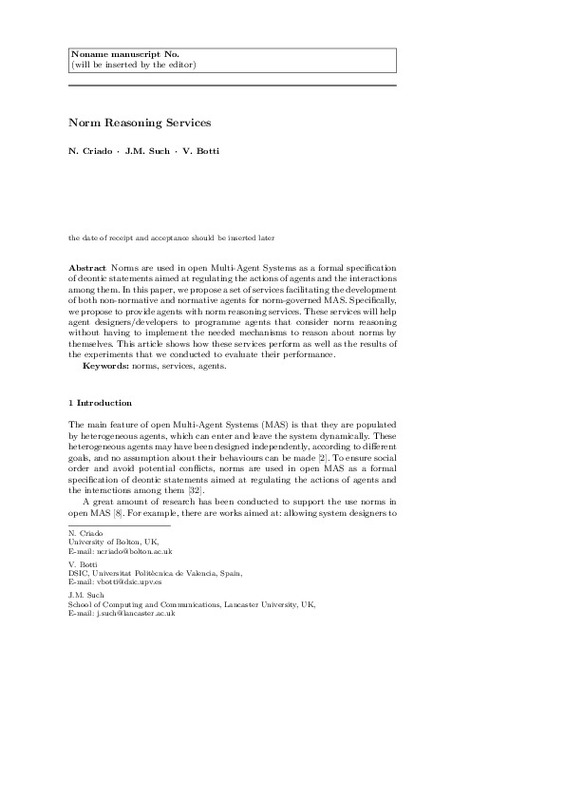Andrighetto G., Campenni M., Conte R., Cecconi F. (2008). Conformity in multiple contexts: imitation vs. norm recognition. In World congress on social simulation (pp. 14–17).
Artikis A., & Pitt J. (2001). A formal model of open agent societies. In Proceeding of the international conference on autonomous agents and multiagent systems (AAMAS) (pp. 192–193).
Bordini R., Hübner J., Wooldridge M. (2008). Programming multi-agent systems in AgentSpeak using Jason (Vol. 8). Wiley-Interscience.
[+]
Andrighetto G., Campenni M., Conte R., Cecconi F. (2008). Conformity in multiple contexts: imitation vs. norm recognition. In World congress on social simulation (pp. 14–17).
Artikis A., & Pitt J. (2001). A formal model of open agent societies. In Proceeding of the international conference on autonomous agents and multiagent systems (AAMAS) (pp. 192–193).
Bordini R., Hübner J., Wooldridge M. (2008). Programming multi-agent systems in AgentSpeak using Jason (Vol. 8). Wiley-Interscience.
Broersen J., Dastani M., Hulstijn J., Huang Z., van der Torre, L (2001). The boid architecture: conflicts between beliefs, obligations, intentions and desires. In Proceedings of the fifth international conference on autonomous agents (pp. 9–16). ACM.
Burdalo L., Garcia-Fornes A., Julian V., Terrasa A. (2011). TRAMMAS: a tracing model for multiagent systems. Engineering Applications of Artificial Intelligence , 24(7), 1110–1119.
Conte R., Andrighetto G., Campenní M., Paolucci M. (2007). Emergent and immergent effects in complex social systems. In Proceeding of the AAAI symposium, social and organizational aspects of intelligence (pp. 42–47).
Conte R., Castelfranchi C., Dignum F. (1999). Autonomous norm acceptance. In Intelligent agents V: agents theories, architectures, and languages (pp. 99–112).
Criado N., Argente E., Botti V. (2011a). Open issues for normative multi-agent systems. AI Communications , 24(3), 233–264.
Criado N., Argente E., Botti V. (2011b). Thomas: an agent platform for supporting normative multi-agent systems. Journal of Logic and Computation.
Criado N., Argente E., Noriega P., Botti V. (2012a). Determining the willingness to comply with norms (Extended Abstract). In Proceeding of the international conference on autonomous agents and multiagent systems (AAMAS).
Criado N., Argente E., Noriega P., Botti V. (2012b). MaNEA: a distributed architecture for enforcing norms in open MAS. Engineering Applications of Artificial Intelligence , 26(1), 76–95.
Criado N., Argente E., Noriega P., Botti V. (2013). Human-inspired model for norm compliance decision making. Information Science , 245, 218–239.
Criado N., Julián V., Botti V., Argente E. (2010). A norm-based organization management system. In Coordination, organizations, institutions and norms in agent systems V (pp. 19–35).
Daft R. (2003). Organization theory and design. South-Western College.
Dignum V., & Dignum F. (2002). Towards an agent-based infrastructure to support virtual organisations. In Proceeding of the working conference on infrastructures for virtual enterprises: collaborative business ecosystems and virtual enterprises (pp. 363–370).
Esteva M., de la Cruz D., Sierra C. (2002). ISLANDER: an electronic institutions editor. In Proceedings of the first international joint conference on autonomous agents and multiagent systems (AAMAS) (Vol. 3, pp. 1045–1052). ACM.
Felicíssimo C., Chopinaud C., Briot J., Seghrouchni A., Lucena C. (2008). Contextualizing normative open multi-agent systems. In Proceedings of the ACM symposium on applied computing (pp. 52–59). ACM.
Ferber J., Michel F., Baez J. (2005). Agre: integrating environments with organizations. In Environments for multi-agent systems (pp. 48–56).
Fogues R.L., Alberola J.M., Such J.M., Espinosa A., Garcia-Fornes A. (2010). Towards dynamic agent interaction support in open multiagent systems. In Proceeding of the international conference of the catalan association for artificial intelligence (CCIA) (Vol. 220, pp. 89–98). IOS Press.
Foster I., Kesselman C., Tuecke S. (2001). The anatomy of the grid: enabling scalable virtual organizations. International Journal of High Performance Computing Applications , 15(3), 200.
Garrido A., Giret A., Botti V., Noriega P. (2013). mWater, a case study for modeling virtual markets. In New perspectives on agreement technologies, volume Law (pp. 563–579). Gover: Springer.
Hubner J., Boissier O., Kitio R., Ricci A. (2010). Instrumenting multi-agent organisations with organisational artifacts and agents. Journal of Autonomous Agents and Multi-Agent Systems , 20(3), 369–400.
Kollingbaum M. (2005). Norm-governed practical reasoning agents. PhD thesis, University of Aberdeen.
López F., Luck M., dInverno M. (2006). A normative framework for agent-based systems. Computational & Mathematical Organization Theory , 12(2), 227–250.
López y López F., & Luck M. (2002). A model of normative multi-agent systems and dynamic relationships. In Proceedings of the workshop on regulated agent-based social systems, LNCS, (Vol. 2934, pp. 259–280). Springer.
Modgil S., Faci N., Meneguzzi F., Oren N., Miles S., Luck M. (2009). A framework for monitoring agent-based normative systems. In Proceeding of the international conference on autonomous agents and multiagent systems (AAMAS) (pp. 153–160).
Nakano T., & Suda T. (2005). Self-organizing network services with evolutionary adaptation. IEEE Transactions on Neural Networks , 16(5), 1269–1278.
Okuyama F., Bordini R., da Rocha Costa A. (2008). A distributed normative infrastructure for situated multi-agent organisations. In Proceeding of the international conference on autonomous agents and multiagent systems (AAMAS) (pp. 1501–1504).
Omicini A., Ricci A., Viroli M. (2008). Artifacts in the A&A meta-model for multi-agent systems. Journal of Autonomous Agents and Multi-Agent Systems , 17(3), 432–456.
Oren N., Panagiotidi S., Vázquez-Salceda J., Modgil S., Luck M., Miles S. (2009). Towards a formalisation of electronic contracting environments. In Coordination, organizations, institutions and norms in agent systems IV (pp. 156–171).
Piunti M., Ricci A., Boissier O., Hubner J. (2009). Embodying organisations in multi-agent work environments. In Proceeding of IEEE/WIC/ACM international joint conferences on web intelligence and intelligent agent technologies (WI-IAT) (Vol. 2, pp. 511–518).
Rubino R., & Sartor G. (2008). Preface. Artificial Intelligence and Law , 16, 1–5.
Savarimuthu B.T.R., & Cranefield S. (2009). A categorization of simulation works on norms. In Normative multi-agent systems, number 09121 in Dagstuhl seminar proceedings.
Such J.M., Espinosa A., García-Fornes A., Botti V. (2011). Partial identities as a foundation for trust and reputation. Engineering Applications of Artificial Intelligence , 24(7), 1128–1136.
[-]






![[Cerrado]](/themes/UPV/images/candado.png)



